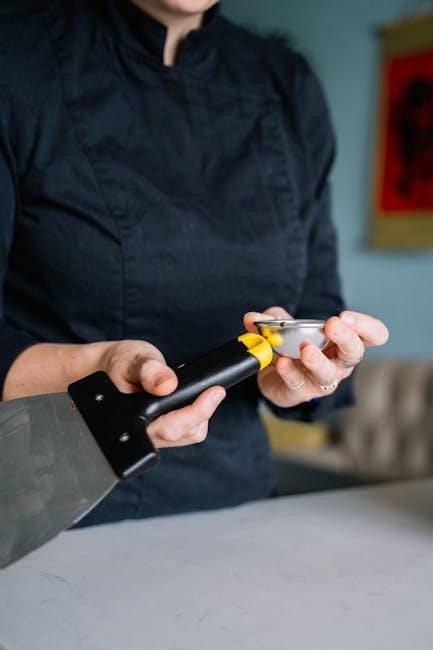Knife sharpening guides provide foundational knowledge on techniques‚ tools‚ and best practices to achieve razor-sharp edges. They cover essential angles‚ honing methods‚ and safety tips for beginners and experts.
1.1 Importance of Knife Sharpening
Knife sharpening is essential for safety‚ efficiency‚ and maintaining blade longevity. A dull knife requires more force‚ increasing the risk of accidents. Sharp knives cut cleanly‚ reducing waste and effort. Proper sharpening enhances edge retention‚ ensuring better performance in various tasks. Regular maintenance prevents rust and extends the knife’s lifespan. Sharpening also preserves the blade’s integrity‚ avoiding costly replacements. It allows for precise control‚ making tasks like cooking or crafting more enjoyable. Overall‚ sharpening is a crucial skill for anyone relying on knives for daily use or professional work.
1.2 Brief History of Knife Sharpening Techniques
Knife sharpening techniques have evolved over centuries‚ with early methods using stones and natural materials. Ancient civilizations sharpened blades on sandstone or ceramic. The Middle Ages introduced whetstones‚ while the Industrial Revolution brought steel and machine-based sharpeners. Modern techniques incorporate electric sharpeners and precise angle guides. Despite advancements‚ traditional methods remain popular for their precision and control. The art of sharpening has adapted to new tools while preserving timeless principles‚ ensuring sharp edges for countless applications.
1.3 Benefits of Properly Sharpened Knives
Properly sharpened knives enhance safety‚ efficiency‚ and precision in cutting tasks. A sharp blade requires less force‚ reducing the risk of accidents and fatigue. It also ensures cleaner cuts‚ preserving the integrity of materials like food or wood. Sharp knives are more durable‚ as they resist wear and tear better than dull ones. Additionally‚ they improve hygiene by preventing the spread of bacteria and making cleaning easier. Overall‚ a well-sharpened knife elevates performance and longevity‚ making it an essential tool for both professionals and home users.

Understanding Knife Sharpening Basics
Understanding knife sharpening basics involves mastering essential concepts like angles‚ bevels‚ and the difference between honing and sharpening. These fundamentals ensure effective blade maintenance and optimal performance.
2.1 Sharpening Angles and Their Significance
Sharpening angles are critical for achieving a sharp‚ durable edge. Typically ranging between 15° and 30°‚ the angle depends on the knife’s intended use‚ with thinner angles suited for precision cuts and thicker angles for robust tasks. Proper alignment ensures even wear and prevents damage. Edge leading strokes help set the angle‚ while resistance feedback guides accuracy. Consistency is key to maintaining the edge’s integrity and performance‚ making angle control a foundational skill in knife sharpening.
2.2 The Role of the Bevel in Knife Sharpening
The bevel is the angled edge of a knife blade‚ crucial for achieving sharpness. Properly maintaining the bevel ensures consistent cutting performance and prevents uneven wear. The bevel’s angle‚ typically matching the knife’s sharpening angle‚ determines its cutting efficiency. Identifying and sharpening the bevel correctly is essential‚ as it directly impacts the knife’s functionality. During sharpening‚ focusing on the bevel helps establish a razor-sharp edge‚ while feedback from resistance or sound indicates proper alignment. Mastery of the bevel is fundamental for effective knife sharpening.
2.3 Difference Between Honing and Sharpening
Sharpening involves removing metal to create a new‚ sharper edge‚ while honing maintains the existing edge by aligning and refining it. Sharpening is typically done with tools like whetstones or sharpeners to address dullness or damage. Honing‚ often using a sharpening steel‚ polishes the blade without significant metal removal‚ maintaining sharpness. Both processes are essential but serve distinct purposes: sharpening restores the edge‚ and honing preserves it. Understanding their roles ensures effective knife maintenance‚ preventing unnecessary wear and extending the blade’s lifespan.
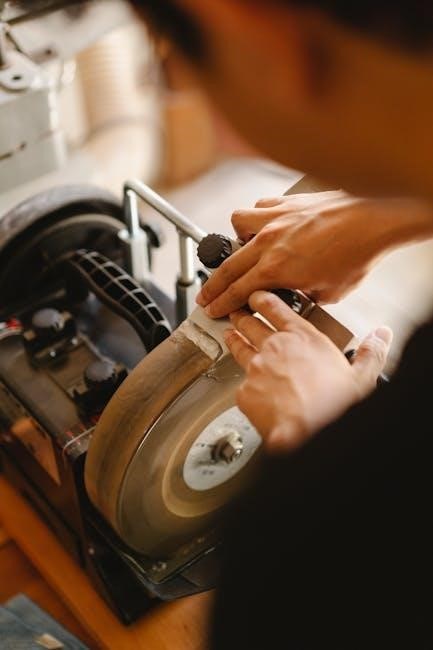
Essential Tools for Knife Sharpening
Whetstones‚ sharpening steels‚ and electric or manual sharpeners are the primary tools for achieving precise edge refinement. Each tool serves a unique purpose in the sharpening process.
3.1 Whetstones: Types and Selection
Whetstones are fundamental for knife sharpening‚ available in various grits and materials. Coarse grit stones (1000-3000) are used for initial sharpening‚ while fine grit (5000-8000) polish the edge. Ceramic and synthetic stones offer durability and consistent results‚ whereas natural Arkansas stones are prized for their quality. Selecting the right whetstone depends on the knife’s material‚ desired sharpness‚ and personal preference. Proper use of whetstones ensures effective edge refinement and maintenance of the blade’s integrity.
3.2 Sharpening Steels: How They Work
Sharpening steels‚ also known as honing steels‚ are essential for maintaining knife sharpness. They work by realigning the blade’s edge rather than removing metal. Available in various materials like diamond-coated‚ ceramic‚ and steel‚ they offer different levels of abrasion. Using a sharpening steel requires proper technique‚ holding the knife at the correct angle and drawing it along the steel’s length. This process enhances edge retention and is a quick method for touch-ups between sharpenings‚ ensuring knives stay sharp and perform optimally in various cutting tasks.
3.3 Electric and Manual Sharpeners: Pros and Cons
Electric sharpeners offer speed and convenience‚ ideal for quick results‚ while manual sharpeners provide precision and control. Electric models often feature preset angles and are user-friendly‚ but may lack the finesse of manual tools. Manual sharpeners‚ like whetstones‚ require skill but allow for customization. Both options are effective‚ with electric being better for beginners and manual suited for experienced users. Magnetic strips can aid angle consistency‚ and one-direction sharpening enhances edge retention. Choosing between them depends on personal preference‚ skill level‚ and the desired sharpness outcome.
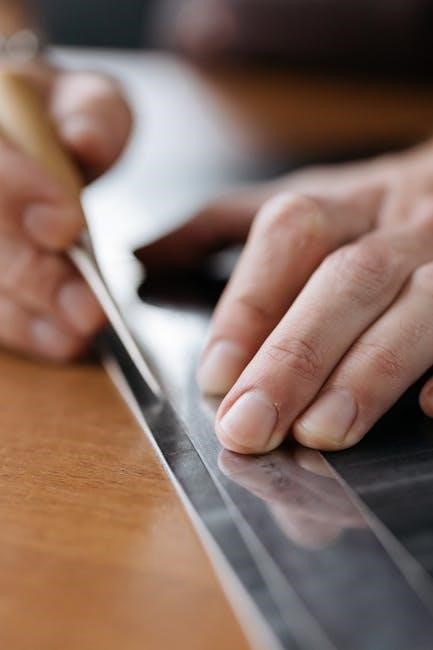
The Sharpening Process
The sharpening process involves specific techniques like edge leading strokes and resistance feedback to achieve sharpness‚ ensuring the knife is prepared and angled correctly for optimal results.
4.1 Preparing the Knife for Sharpening
Preparing the knife involves inspecting the blade for damage and cleaning it to ensure a smooth sharpening process. Proper posture and hand placement are crucial for control and safety.
4.2 Setting the Correct Sharpening Angle
Setting the correct sharpening angle is crucial for achieving a sharp edge. Most knives are sharpened at angles between 15° and 30°‚ depending on their intended use. To determine the angle‚ place the knife on the sharpening tool and adjust until the blade aligns with the desired angle. Edge-leading strokes help maintain consistency‚ while resistance feedback indicates proper contact with the sharpening surface. Magnetic strips can also be used to maintain angle consistency during the process.
4.3 Edge Leading Strokes and Resistance Feedback
Edge-leading strokes are essential for maintaining consistent sharpening angles and ensuring even edge wear. Start by placing the knife on the sharpening surface with the bevel flat. Lightly draw the blade from heel to tip‚ applying gentle pressure. Resistance feedback indicates proper contact with the sharpening medium. If the knife slips forward‚ the angle is too small; if it feels too rigid‚ the angle may be too large. Adjust the angle based on this feedback to achieve the desired sharpness and edge retention.
4.4 Avoiding Common Mistakes During Sharpening
Common mistakes during sharpening include using too much pressure‚ which can damage the edge‚ and inconsistent sharpening angles‚ leading to uneven results. Forgetting to check the edge’s progress can result in over-sharpening or under-sharpening. Additionally‚ neglecting to maintain the correct bevel angle can cause the knife to become dull quickly. To avoid these errors‚ focus on light‚ controlled strokes‚ use the right sharpening tool for your knife type‚ and regularly inspect the edge’s sharpness. Adjusting the angle based on resistance feedback ensures a sharper‚ more durable edge.
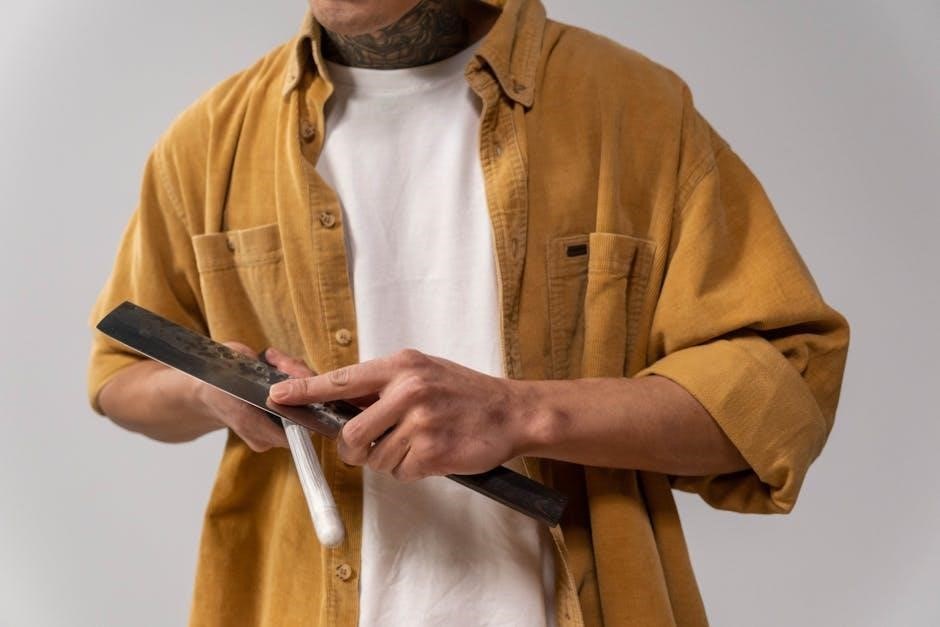
Advanced Sharpening Techniques
Advanced techniques refine edge sharpness and consistency. Magnetic strips ensure precise angles‚ while one-direction sharpening enhances edge retention. These methods elevate sharpening precision and efficiency for professionals.
5.1 Sharpening the Heel and Tip of the Blade
Sharpening the heel and tip requires extra attention due to their curvature and critical roles in cutting. Using edge-leading strokes‚ apply consistent pressure and angle control. Magnetic strips can help maintain precise angles for uniform sharpening. Focus on one-direction strokes to prevent unevenness and enhance edge retention. These techniques ensure the blade’s most challenging areas are sharp and durable‚ improving overall performance and longevity.
5.2 Using Magnetic Strips for Angle Consistency
Magnetic strips are invaluable for maintaining consistent sharpening angles. By securing the knife at preset angles (e.g.‚ 20° or 15°) on a wooden block‚ they prevent slippage and ensure uniform edge sharpening. This method is particularly useful for beginners‚ as it guides the blade into the correct position. The strips enhance precision and consistency‚ allowing for a sharper‚ more durable edge. Regular use of magnetic strips helps develop muscle memory for angle control‚ making the sharpening process more efficient and effective over time.
5.3 One-Direction Sharpening for Better Edge Retention
Sharpening in one direction‚ typically from heel to tip‚ enhances edge retention by aligning microserrations uniformly. This method reduces wire and prevents the edge from becoming too aggressive. It also minimizes metal removal‚ preserving the knife’s longevity. One-direction stroking is faster and produces a sharper edge compared to bidirectional sharpening. By maintaining consistent pressure and angle‚ this technique ensures a polished‚ durable edge that resists wear. Over time‚ it becomes second nature‚ improving both efficiency and results for sharpening enthusiasts and professionals alike‚ ensuring knives stay sharp longer and perform better in various tasks.

Maintenance and Care After Sharpening
Proper storage‚ regular honing‚ and thorough cleaning are essential for maintaining sharpness and preventing rust. These practices ensure knives remain in optimal condition for consistent performance.
6.1 Storing Sharpened Knives Properly
Proper storage is crucial to maintain sharpness and prevent damage. Use magnetic strips or wood blocks to hold knives at safe angles‚ avoiding loose storage. Dry blades thoroughly before storing to prevent rust. Protect edges with sheaths or rolling cases for added safety and convenience. Regular inspection ensures blades remain in prime condition‚ ready for use when needed. Proper storage extends knife longevity and maintains their sharp‚ functional state over time.
6.2 Regular Honing to Maintain Sharpness
Regular honing is essential for maintaining knife sharpness. It involves light strokes along a steel or ceramic hone to realign the blade’s edge. This process doesn’t remove metal but refines the edge‚ preventing dulling. Honing should be done frequently‚ even after minor use‚ to extend the knife’s sharpness. Proper technique ensures the blade remains precise and effective‚ reducing the need for full sharpening. Consistent honing preserves the knife’s performance and longevity‚ making it a key part of knife maintenance.
6.3 Cleaning and Drying to Prevent Rust
Cleaning and drying are crucial steps in preventing rust on sharpened knives. Always wipe the blade with a clean cloth after use to remove moisture and residue. Regularly inspect for signs of rust and address them promptly. For added protection‚ apply a thin layer of food-safe oil to the blade. Store knives in a dry environment‚ avoiding humid areas. Proper care ensures the knife remains rust-free‚ maintaining its edge and longevity. Consistency in these practices is key to preserving your knife’s quality and functionality.
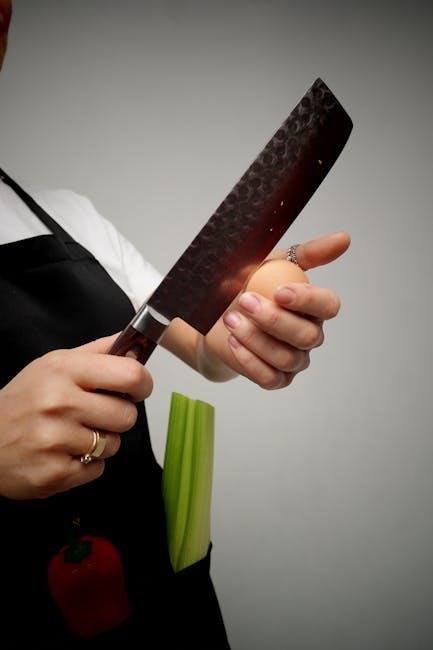
Safety Tips for Knife Sharpening
Safety is paramount in knife sharpening. Maintain proper posture‚ keep fingers away from the blade‚ and use protective gear. Always sharpen away from your body to minimize accidents.
7.1 Proper Posture and Hand Placement
Proper posture and hand placement are crucial for safe knife sharpening. Sit or stand with a straight back‚ keeping the knife away from your body. Grip the knife firmly but controlled‚ with fingers positioned to avoid the blade’s edge. Maintain focus to prevent accidents. Always sharpen away from your body and keep loose clothing tied back. Ensure your workspace is clear and well-lit. Proper hand placement prevents slips and ensures consistent sharpening angles‚ reducing the risk of injury.
7.2 Avoiding Accidents with Sharp Blades
Avoiding accidents with sharp blades requires attention and caution. Always maintain focus and keep the blade away from your body. Use a consistent sharpening angle and apply gentle‚ controlled strokes. Never sharpen while distracted or fatigued. Wear protective gear‚ such as gloves‚ if needed. Ensure your workspace is clear of obstructions. Keep fingers away from the edge and avoid over-reach. Proper posture and hand placement are key to preventing slips. Regular practice improves control‚ reducing the risk of injury. Stay alert and patient during the sharpening process for safe results.
7.3 Using Protective Gear While Sharpening
Using protective gear is crucial for safety during knife sharpening. Gloves protect hands from cuts‚ while safety glasses shield eyes from debris. A cut-resistant apron can prevent clothing damage. Ensure all gear fits comfortably to avoid hindering movement. Choose high-quality materials designed for sharp objects. Regularly inspect gear for wear and tear. Proper protective equipment minimizes risks‚ allowing focus on the sharpening technique. Stay protected to enjoy a safe and effective sharpening experience every time.
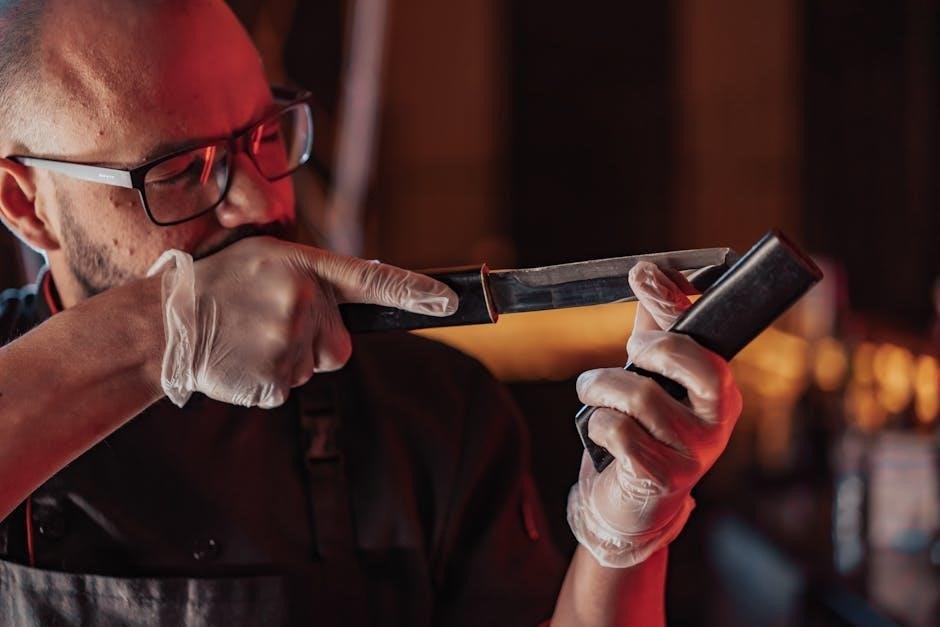
Troubleshooting Common Issues
Troubleshooting common knife sharpening issues involves identifying and addressing problems like dull edges‚ uneven sharpening‚ or difficulty achieving sharpness. Proper techniques and tools can resolve these challenges effectively.
8.1 Fixing a Dull or Chipped Edge
A dull or chipped edge can be repaired by reprofiling the blade. Start with coarse-grit whetstones to remove damaged metal‚ then progress to finer grits for polishing. Ensure consistent angles and light pressure to avoid worsening the chip. Regular sharpening and honing can prevent such issues. Patience and precise strokes are key to restoring the edge effectively.
8.2 Correcting Uneven Sharpening
To correct uneven sharpening‚ inspect the blade visually or use a marker to identify uneven areas. Adjust your sharpening angle and stroke consistency‚ focusing on the problematic sections. Light pressure and precise strokes help restore balance. Avoid over-sharpening‚ as this can worsen the issue. Finish by honing the entire edge with a sharpening steel to ensure uniform sharpness and alignment. Regular practice improves control‚ reducing the likelihood of uneven results in the future.
8.3 Dealing with Difficulty in Achieving Sharpness
When struggling to achieve sharpness‚ check if the sharpening angle is correct for the knife type. Ensure the bevel is properly aligned and maintained throughout the process. Using the right sharpening tool‚ such as a whetstone or sharpening steel‚ is crucial. Light‚ consistent strokes and edge-leading techniques can help improve results. If the blade feels dull‚ repeat the sharpening process‚ focusing on resistance feedback. Regular honing and avoiding excessive pressure are key to overcoming difficulty and achieving a sharp edge. Patience and practice refine sharpening skills over time.

Choosing the Right Knife for Sharpening
Selecting the right knife involves considering blade material‚ edge type‚ and intended use. Proper knife selection ensures effective sharpening and optimal performance for specific tasks and cutting needs.
9.1 Factors to Consider in Knife Selection
When selecting a knife for sharpening‚ consider blade material‚ edge type‚ and intended use. Steel type‚ such as stainless or carbon‚ affects sharpening difficulty. Edge geometry‚ like straight or serrated‚ impacts technique. Blade size and thickness also matter‚ as they influence sharpening angle and stroke consistency. Additionally‚ the knife’s design‚ such as chef‚ hunting‚ or utility‚ dictates specific sharpening needs. Understanding these factors ensures proper sharpening and optimal performance for the knife’s intended purpose‚ enhancing both safety and efficiency in various cutting tasks.
9.2 Knife Materials and Their Sharpening Needs
Knife materials vary‚ influencing sharpening approaches. Stainless steel blades are durable but harder to sharpen‚ requiring more pressure and higher grit whetstones. Carbon steel knives sharpen easily but demand regular maintenance to prevent rust. Damascus steel‚ a mix of metals‚ combines durability with ease of sharpening. Ceramic knives‚ though tough‚ need diamond stones for sharpening. Titanium knives are corrosion-resistant but softer‚ requiring gentler techniques. Each material’s properties dictate specific sharpening methods to achieve and maintain sharpness effectively.
9.3 Sharpening Different Types of Knives
Sharpening techniques vary based on knife types. Chef’s knives require consistent angles for even edges‚ while pocket knives need careful handling due to their size. Serrated knives demand precise strokes along each tooth. Cleavers‚ with their thick blades‚ focus on straight‚ powerful strikes. Hunting knives often require sharper angles for precision‚ and fillet knives need flexible‚ smooth sharpening to maintain their curve. Each knife type has unique needs‚ ensuring proper sharpness for its intended use.

The Importance of Consistency in Sharpening
Consistency in sharpening builds skill and ensures reliable results. Regular practice develops muscle memory‚ improving technique and edge retention over time with every knife you sharpen.
10.1 Developing Muscle Memory for Sharpening
Developing muscle memory for sharpening requires consistent practice and repetition. By repeatedly practicing proper techniques‚ such as maintaining the correct angle and stroke direction‚ you build familiarity with the process. Over time‚ your hands learn the precise movements needed to sharpen effectively‚ making the process more intuitive and efficient. Regular practice helps solidify these skills‚ ensuring that each sharpening session yields consistent results and improves overall knife maintenance.
10.2 Tracking Progress in Sharpening Skills
Tracking progress in sharpening skills involves monitoring improvements in edge sharpness and consistency. Start by testing the knife’s performance before and after sharpening‚ using tasks like cutting paper or tomatoes. Keep a sharpening journal to log each session‚ noting the techniques used and the results. Over time‚ observe how your ability to maintain consistent angles and strokes improves‚ leading to better edge retention and sharper blades. Regularly comparing past and current results helps identify advancements in your sharpening technique and highlights areas for further refinement.
10.3 Practicing Regularly to Improve Technique
Regular practice is essential for mastering knife sharpening. Consistent sessions help develop muscle memory and refine your technique. Focus on maintaining proper angles and strokes‚ as repetition enhances precision. Start with inexpensive knives to build confidence and experiment without risk. Over time‚ you’ll notice improvements in edge quality and sharpness. Patience is key‚ as skill development is gradual. Each sharpening session brings you closer to achieving professional-level results and maintaining sharp‚ reliable blades.
